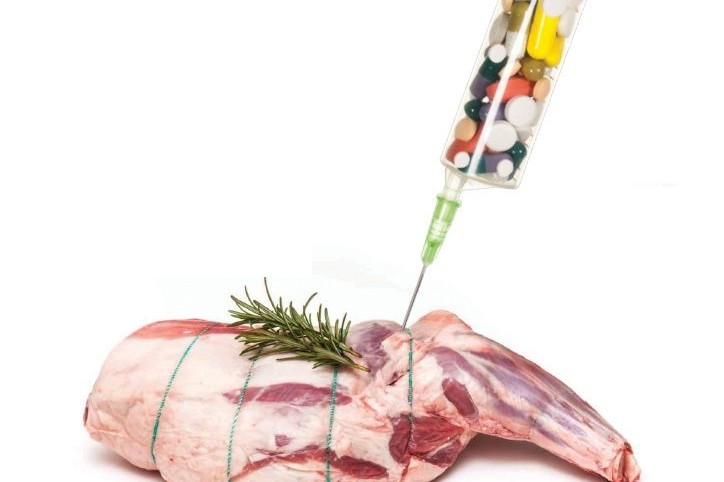Among consumers, there is an increasing concern around issues such as animal welfare and antibiotic resistance in meat products. This has led to the development of quality assurance programmes with several leading meat processing companies, giving premiums to farms that can prove their lambs are produced under certain conditions.
These lambs can then be marketed as, for example, “antibiotic-free”, “raised without GMOs, Antibiotics or Hormones”, “highest level of ethical production” and even “Gluten free”!
Why antibiotic-free? Some of the responsibility for development of antibiotic resistance has been put on overuse of antibiotics in confinement agriculture operations overseas (particularly in developing countries). This is not the way we use antibiotics routinely in New Zealand, where there is virtually no mass treatment of entire mobs of animals with antibiotics.
The main reason we don’t use antibiotics this way is because our country’s biosecurity standards keep out certain diseases that are difficult to control without preventive antibiotics.
Antibiotic products used appropriately (in an individual animal for a specific illness or disease likely to respond to that, and following our responsible use of antibiotics standards) and slaughtered after an appropriate withholding period (and meat is vigilantly checked at slaughter to find any animals where this was not applied) is not a risk for developing resistance. But consumers are not always aware of just how ethical and sustainable NZ meat is.
The advantage of an “antibiotic-free” scheme is that it gives consumers extra confidence in the way the animals have been raised. The disadvantage is that it implies meat not sold under these schemes is not “antibiotic-free”, even though it is.
The programmes I investigated are Silver Ferns Farms, Alliance group, Ovation, and GAP4/ Atkins Ranch (which should cover the majority of the schemes available to farmers). Here is a summary of the main features:.
- None of these protocols stipulate antibiotics must not be used or held on the farm.
- Each of these programmes stipulates animals that are treated with antibiotics must be identified – some schemes stipulate how they should be identified (i.e. a red tag in each ear), others leave that up to the farmer.
Lambs identified as treated with antibiotics must be sent to slaughter
separately, and slaughtered in a separate line. Farmers need to send a separate ASD form with the lambs being slaughtered as antibiotic-free.
- Breeding stock can be treated with antibiotics – indirect treatment does not stop the lambs being marketed as antibiotic-free (i.e. if you give antibiotics to a ewe with a bearing her lamb can still be sold as antibiotic-free even though it may have consumed antibiotic metabolites through the milk).
- Finishing farms can’t sell lambs they have bought in as Ab-free unless they have documented proof of the farm of origin’s involvement in an Ab-free scheme.
- There is variation in the intensity and timing of auditing these schemes on the farm – each scheme involves some sort of auditing, mostly through AsureQuality.
- If a farmer has a disease outbreak that requires use of antibiotics they miss out on the premium for those lambs but it would not compromise their involvement in the Ab-free scheme.
- The premium to farmers for selling lambs as Ab-free varies from 5c/kg to 20c/kg carcase ($1-6/head).
Each of the people I spoke to indicated these schemes were increasing in popularity and the majority of their farmers would supply some lambs through the Ab Free lines. I was focusing on programmes for lambs, but equivalent programmes exist for beef and deer.
Discussions with farmers seem to indicate most farmers who are part of these schemes go above and beyond these requirements. For example, if I discuss the use of antibiotics in breeding stock some will say “oh, we can’t use any antibiotics on farm!” They may want to make it easier for farm staff, or not want to risk an animal being treated and not identified.
I am concerned about potential animal welfare issues in these cases. In other words, I am concerned farmers may withhold appropriate antibiotic treatment to make it easier to stick with these schemes, and that animal welfare may suffer.
Routine prophylactic use of antibiotics should be avoided – no use of antibiotics in healthy animals is a realistic and achievable goal. There is minimal use of antibiotics in sheep and beef systems anyway. Where an animal is sick from a disease that is likely to respond to antibiotics it should be treated (or euthanised). In the very rare situations where there is a conflict between animal welfare and market access requirements, animal welfare has to come first.
I wholeheartedly support farmers getting a premium for not using prophylactic antibiotics – it is great that overseas consumers can recognise at least some of the benefits of our remarkable NZ production system. Where there is an issue it seems to be one of farmers misunderstanding the criteria or not wanting to take the risk of falling foul of an audit even if they are following the rules.
What would the ideal scheme include?
I think antibiotic-free schemes should include provision for antibiotic use in individual cases where veterinary input has determined antibiotics are necessary to maintain a standard of animal welfare. I think schemes should make it much more clear that where antibiotic treatment is necessary then withholding treatment in order to access those premiums is never acceptable.
I also would like to see farmers get a premium for routine use of pain relief. In animal welfare terms I think this would result in better outcomes than the current schemes.
- Sara Sutherland is a Wairarapa veterinarian, this article was written in August 2021.





